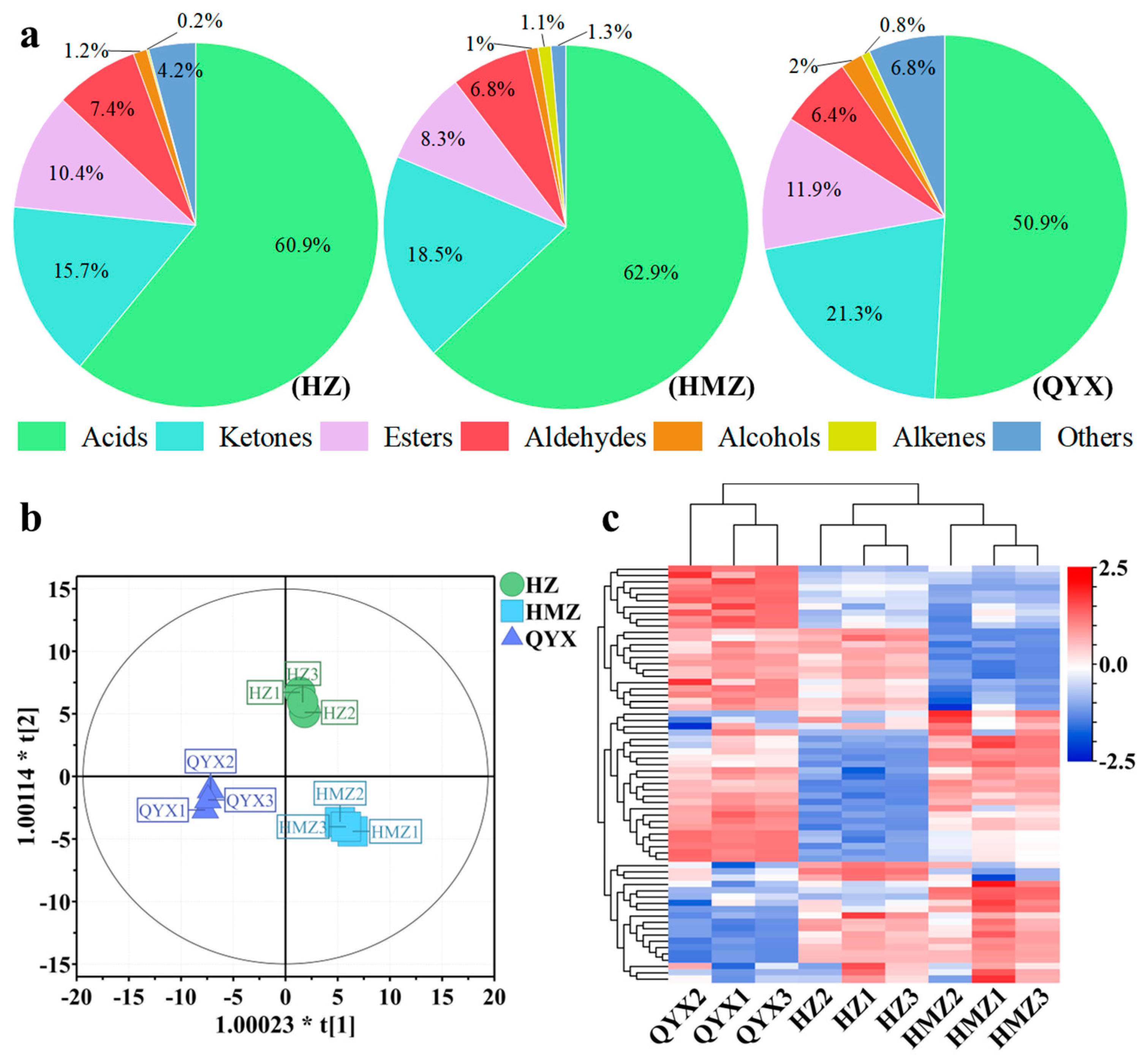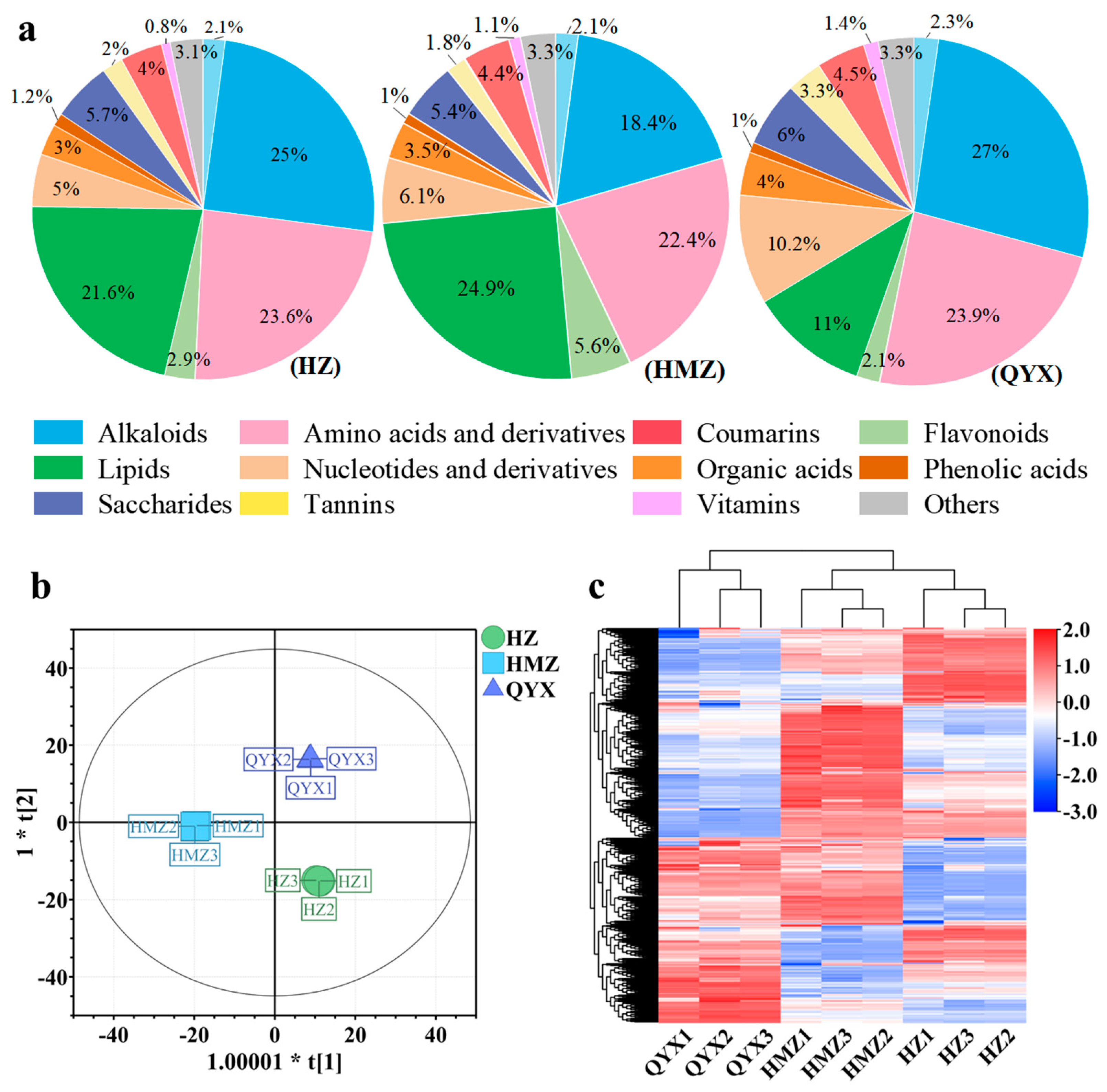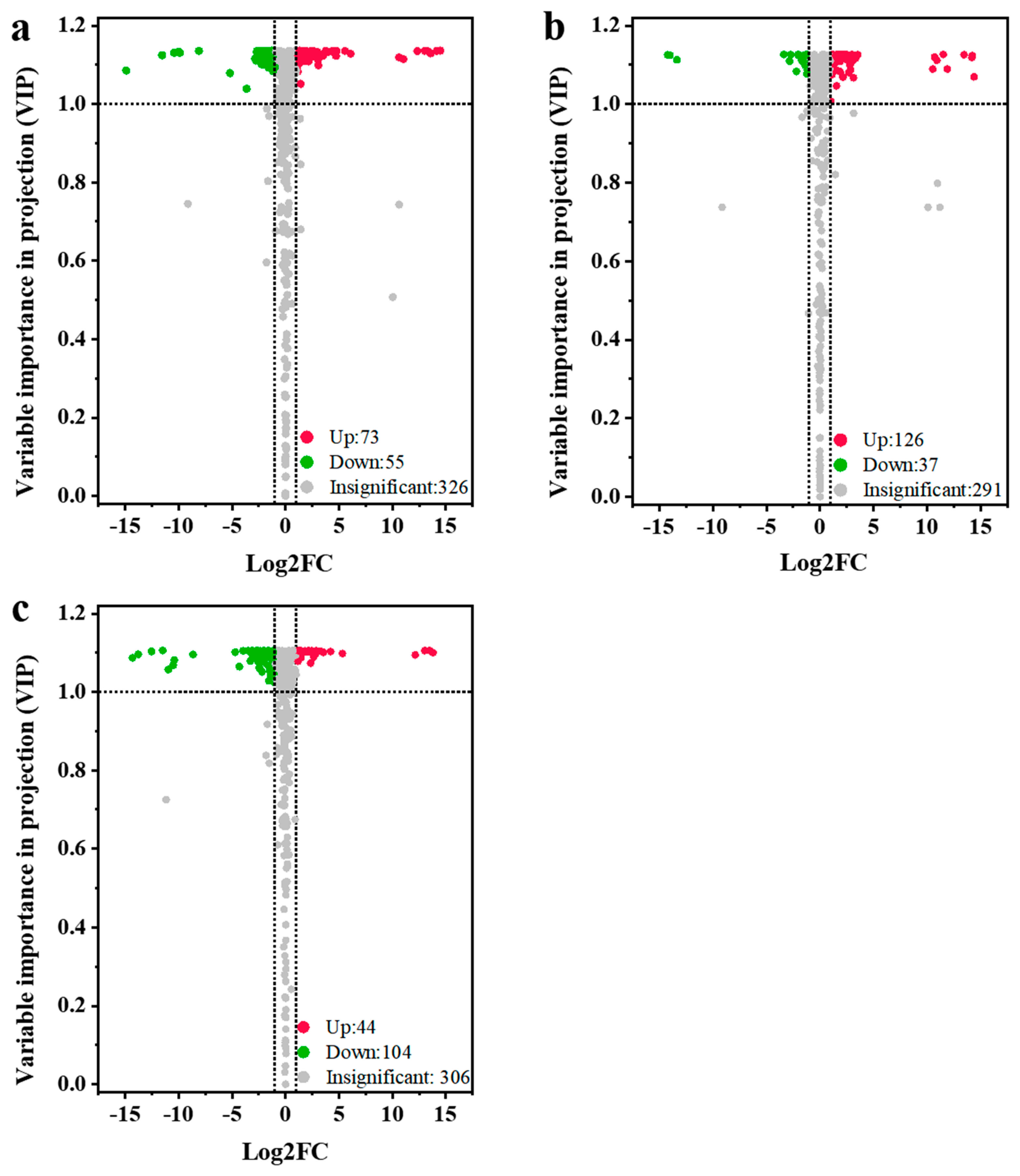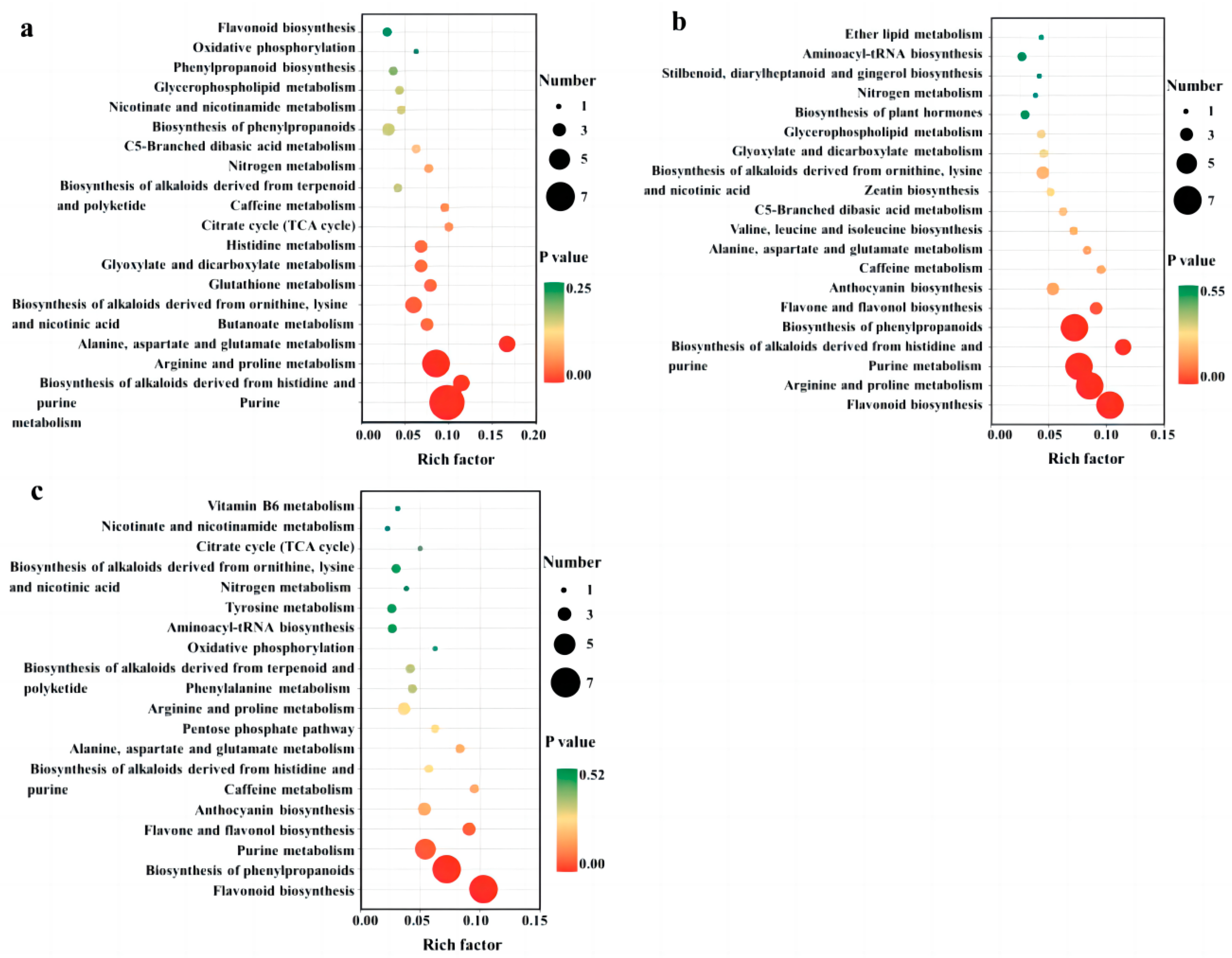The Flavor Characteristics and Metabolites of Three Commercial Dried Jujube Cultivars
Abstract
:1. Introduction
2. Materials and Methods
2.1. Plant Materials and Chemicals
2.2. Determination of Sugars and Acids in Different Jujube Cultivars
2.2.1. Sugar Standard Curve Preparation
2.2.2. Acid Standard Curve Preparation
2.3. Determination of VOCs in Different Jujube Cultivars
2.4. Relative Odor Activity Value (ROAV) Calculation of VOCs
2.5. Widely Targeted Metabolomic Analysis of Different Jujube Cultivars
2.5.1. Sample Preparation and Metabolite Extraction
2.5.2. HPLC Conditions and ESI-Q TRAP-MS/MS Analysis
2.5.3. Qualitative and Quantitative Determination of Metabolites
2.6. Statistical Analysis
3. Results and Discussion
3.1. Main Soluble Sugars and Organic Acids of Different Jujube Cultivars
3.2. VOC Profiles of Different Jujube Cultivars
3.3. Key Flavor VOCs of Different Jujube Cultivars
3.4. Metabolite Profiles of Different Jujube Cultivars
3.5. Differential Metabolites among Different Jujube Cultivars
3.5.1. Lipids
3.5.2. Flavonoids and Alkaloids
3.5.3. Nucleotides and Derivatives
3.5.4. Other Metabolites
3.6. KEGG Pathway Enrichment Analysis of the Differential Metabolites
4. Conclusions
Supplementary Materials
Author Contributions
Funding
Institutional Review Board Statement
Informed Consent Statement
Data Availability Statement
Acknowledgments
Conflicts of Interest
References
- Gao, Q.H.; Wu, C.S.; Wang, M. The jujube (Ziziphus jujuba Mill.) fruit: A review of current knowledge of fruit composition and health benefits. J. Agric. Food Chem. 2013, 61, 3351–3363. [Google Scholar] [CrossRef] [PubMed]
- Guo, S.; Duan, J.A.; Qian, D.W.; Tang, Y.P.; Wu, D.W.; Su, S.L.; Wang, H.Q.; Zhao, Y.N. Content variations of triterpenic acid, nucleoside, nucleobase, and sugar in jujube (Ziziphus jujuba) fruit during ripening. Food Chem. 2015, 167, 468–474. [Google Scholar] [CrossRef]
- Huang, J.; Yang, X.T.; Zhang, C.M.; Yin, X.; Liu, S.P.; Li, X.G. Development of Chloroplast Microsatellite Markers and Analysis of Chloroplast Diversity in Chinese Jujube (Ziziphus jujuba Mill.) and Wild Jujube (Ziziphus acidojujuba Mill.). PLoS ONE 2015, 10, e134519. [Google Scholar] [CrossRef]
- Huang, J.; Zhang, C.; Zhao, X.; Fei, Z.; Wan, K.; Zhang, Z.; Pang, X.; Yin, X.; Bai, Y.; Sun, X.; et al. The Jujube Genome Provides Insights into Genome Evolution and the Domestication of Sweetness/Acidity Taste in Fruit Trees. PLoS Genet. 2016, 12, e1006433. [Google Scholar] [CrossRef] [PubMed]
- Li, X.G. Chinese Jujube Industry; China Forestry Publishing House: Beijing, China, 2015. [Google Scholar]
- Li, X.G.; Huang, J.; Gao, W.H. A study on high-quality production regions of dry Chinese jujube in China. J. Fruit Sci. 2005, 22, 620–625. [Google Scholar]
- Zhou, L.; Yang, W.Z.; Wang, C.Z.; Li, X.G. Superior production region of Chinese jujube in Xinjiang. J. Fruit Sci. 2015, 32, 453–459. [Google Scholar]
- Li, D.K.; Niu, X.W.; Tian, J.B. The Illustrated Germplasm Resources of Chinese Jujube; China Agriculture Press: Beijing, China, 2013. [Google Scholar]
- Qu, Z.Z.; Wang, Y.H. Records of Chinese Fruits: Jujube; Chinese Forestry Press: Beijing, China, 1993. [Google Scholar]
- Wang, C.Z.; Gao, J.C.; Liu, Z.Z.; Gao, H. An Early Maturity Jujube Cultivar—‘Qiyuexian’. Acta Hortic. Sin. 2003, 30, 499. [Google Scholar] [CrossRef]
- Kou, X.H.; Chen, Q.; Li, X.H.; Li, M.F.; Kan, C.; Chen, B.R.; Zhang, Y.; Xue, Z.H. Quantitative assessment of bioactive compounds and the antioxidant activity of 15 jujube cultivars. Food Chem. 2015, 173, 1037–1044. [Google Scholar] [CrossRef] [PubMed]
- Wan, C.; Han, G. Advances in research on jujube flavor. J. Fruit Sci. 2020, 37, 920–928. [Google Scholar] [CrossRef]
- Xia, X.X.; Xue, A.L.; Kou, F.B.; Ran, H.; Lei, X.J.; Zhao, J.C.; Zeng, K.F.; Ming, J. Formation mechanism of characteristic aroma substances during jujube processing: A review. Food Ferment. Ind. 2021, 47, 288–297. [Google Scholar] [CrossRef]
- Zhu, J.C.; Xiao, Z.B. Characterization of the major odor-active compounds in dry jujubes cultivars by application of gas chromatography-olfactometry and odor activity value. J. Agric. Food Chem. 2018, 29, 7722–7734. [Google Scholar] [CrossRef] [PubMed]
- Bae, J.H.; Lee, J.H.; Kwon, K.I.; Im, M.H.; Park, G.S.; Lee, J.G.; Choi, H.J.; Jeong, S.Y. Quality Characteristics of the White Bread Prepared by Addition of Jujube Extracts. Korean J. Food Sci. Technol. 2005, 37, 603–610. [Google Scholar]
- Ahmed, K.R.; Naymul, K.; Mohammad, R.I.S.; Tao, B.; Yang, L.; Wei, C. Jujube fruit: A potential nutritious fruit for the development of functional food products. J. Funct. Foods 2020, 75, 104205. [Google Scholar] [CrossRef]
- Li, J.C.; Fan, Y.M.; Huang, G.L.; Huang, H.L. Extraction, structural characteristics and activities of Zizylphus vulgaris polysaccharides. Ind. Crops Prod. 2022, 178, 114675. [Google Scholar] [CrossRef]
- Bai, L.; Zhang, H.; Liu, Q.C.; Zhao, Y.; Cui, X.Q.; Guo, S.; Zhang, L.; Ho, C.T.; Bai, N.S. Chemical characterization of the main bioactive constituents from fruits of Ziziphus jujuba. Food Funct. 2016, 7, 2870–2877. [Google Scholar] [CrossRef] [PubMed]
- Ghani, A.; Amini, S.; Mohtashami, S.; Neamati, S.H. Physicochemical and biochemical variations of jujube (Ziziphus jujuba Mill.) populations: A comparison of Iranian and imported types. Ind. Crops Prod. 2022, 183, 114898. [Google Scholar] [CrossRef]
- Ji, X.L.; Hou, C.Y.; Gao, Y.G.; Xue, Y.Q.; Yan, Y.Z.; Guo, X.D. Metagenomic analysis of gut microbiota modulatory effects of jujube (Ziziphus jujuba Mill. polysaccharides in a colorectal cancer mouse model. Food Funct. 2019, 11, 163–173. [Google Scholar] [CrossRef] [PubMed]
- Wang, L.N.; Wang, Y.Q.; Wang, W.Z.; Zheng, F.P.; Chen, F. Comparison of volatile compositions of 15 different varieties of Chinese jujube (Ziziphus jujuba Mill.). J. Food Sci. Technol. 2019, 56, 1631–1640. [Google Scholar] [CrossRef]
- Shen, B.; Zhang, Z.; Shi, Q.; Du, J.; Xue, Q.; Li, X. Active compound analysis of Ziziphus jujuba cv. Jinsixiaozao in different developmental stages using metabolomic and transcriptomic approaches. Plant Physiol. Biochem. 2022, 189, 14–23. [Google Scholar] [CrossRef]
- Li, S.; Deng, B.; Tian, S.; Guo, M.; Liu, H.; Zhao, X. Metabolic and transcriptomic analyses reveal different metabolite biosynthesis profiles between leaf buds and mature leaves in Ziziphus jujuba Mill. Food Chem. 2021, 347, 129005. [Google Scholar] [CrossRef]
- Shi, Q.Q.; Du, J.T.; Zhu, D.J.; Li, X.; Li, X.G. Metabolomic and Transcriptomic Analyses of Anthocyanin Biosynthesis Mechanisms in the Color Mutant Ziziphus jujuba cv. Tailihong. J. Agric. Food Chem. 2020, 68, 15186–15198. [Google Scholar] [CrossRef] [PubMed]
- Wang, C.; Lv, W.X.; Gao, J.C.; Jia, Y.Y.; Liu, H.P.; Han, G. Study on dry fruit flavor of Huizao and Junzao jujubes from different habitats. J. Fruit Sci. 2021, 38, 1921–1929. [Google Scholar] [CrossRef]
- Li, K.; Tang, J.J.; Zhang, Z.X.; Wu, Z.Q.; Zhong, A.A.; Li, Z.J.; Wang, Y.L. Correlation between flavor compounds and microorganisms of Chaling natural fermented red sufu. LWT 2022, 154, 112873. [Google Scholar] [CrossRef]
- Chen, W.; Gong, L.; Guo, Z.L.; Wang, W.S.; Zhang, H.Y.; Liu, X.Q.; Yu, S.B.; Xiong, L.Z.; Luo, J. A Novel Integrated Method for Large-Scale Detection, Identification, and Quantification of Widely Targeted Metabolites: Application in the Study of Rice Metabolomics. Mol. Plant 2013, 6, 1769–1780. [Google Scholar] [CrossRef] [PubMed]
- Chen, C.J.; Chen, H.; Zhang, Y.; R Thomas, H.; H Frank, M.; He, Y.H.; Xia, R. TBtools: An Integrative Toolkit Developed for Interactive Analyses of Big Biological Data. Mol. Plant 2020, 13, 1194–1202. [Google Scholar] [CrossRef]
- Fraga, C.G.; Clowers, B.H.; Moore, R.J.; Zink, E.M. Signature-discovery approach for sample matching of a nerve-agent precursor using liquid chromatography-mass spectrometry, XCMS, and chemometrics. Anal. Chem. 2010, 82, 4165–4173. [Google Scholar] [CrossRef] [PubMed]
- Wu, Z.F.; Tu, M.M.; Yang, X.P.; Xu, J.H.; Yu, Z.F. Effect of cutting and storage temperature on sucrose and organic acids metabolism in postharvest melon fruit. Postharvest Biol. Technol. 2020, 161, 111081. [Google Scholar] [CrossRef]
- Li, J.W.; Fan, L.P.; Ding, S.D.; Ding, X.L. Nutritional composition of five cultivars of chinese jujube. Food Chem. 2006, 103, 454–460. [Google Scholar] [CrossRef]
- Pu, Y.F.; Ding, T.; Wang, W.J.; Xiang, Y.J.; Ye, X.Q.; Li, M.; Liu, D.H. Effect of harvest, drying and storage on the bitterness, moisture, sugars, free amino acids and phenolic compounds of jujube fruit (Zizyphus jujuba cv. Junzao). J. Sci. Food Agric. 2018, 2, 628–634. [Google Scholar] [CrossRef]
- Zheng, B.B.; Zhao, L.; Jiang, X.H.; Cherono, S.; Liu, J.J.; Ogutu, C.; Ntini, C.; Zhang, X.; Han, Y.P. Assessment of organic acid accumulation and its related genes in peach. Food Chem. 2021, 334, 127567. [Google Scholar] [CrossRef]
- Gao, Q.H.; Wu, C.S.; Wang, M.; Xu, B.N.; Du, L.J. Effect of drying of jujubes (Ziziphus jujuba Mill.) on the contents of sugars, organic acids, α-tocopherol, β-carotene, and phenolic compounds. J. Agric. Food Chem. 2012, 60, 9642–9648. [Google Scholar] [CrossRef] [PubMed]
- Fu, L.; Yang, J.N.; Shang, H.L.; Song, J.X. Changes of characteristic sugar, fatty acid, organic acid and amino acid in jujubes at different dry mature stages. J. Food Compos. Anal. 2021, 104, 104104. [Google Scholar] [CrossRef]
- Baldwin, E.A.; Scott, J.W.; Shewmaker, C.K.; Schuch, W. Flavor Trivia and Tomato Aroma: Biochemistry and Possible Mechanisms for Control of Important Aroma Components. Hortscience 2000, 35, 1013–1022. [Google Scholar] [CrossRef]
- Liu, Y.X.; Sang, Y.Y.; Guo, J.Y.; Zhang, W.D.; Zhang, T.Y.; Wang, H.; Cheng, S.B.; Chen, G.G. Analysis of volatility characteristics of five jujube varieties in Xinjiang Province, China, by HS-SPME-GC/MS and E-nose. Food Sci. Nutr. 2021, 12, 6617–6626. [Google Scholar] [CrossRef] [PubMed]
- Song, J.X.; Chen, Q.Q.; Bi, J.F.; Meng, X.J.; Wu, X.Y.; Qiao, Y.N.; Lyu, Y. GC/MS coupled with MOS e-nose and flash GC e-nose for volatile characterization of Chinese jujubes as affected by different drying methods. Food Chem. 2020, 331, 127201. [Google Scholar] [CrossRef] [PubMed]
- Li, C.H.; Zhao, Y.; Li, W.J.; Xing, R.R.; Lu, J.; Liu, R.X. UHPLC-UV-Q-Orbitrap HRMS combined with machine learning algorithms reveals the chemical markers of Euodiae Fructus among closely related cultivars. Ind. Crops Prod. 2021, 162, 113279. [Google Scholar] [CrossRef]
- Wang, H.J.; Hua, J.J.; Yu, Q.Y.; Li, J.; Wang, J.J.; Deng, Y.L.; Yuan, H.B.; Jiang, Y.W. Widely targeted metabolomic analysis reveals dynamic changes in non-volatile and volatile metabolites during green tea processing. Food Chem. 2021, 363, 130131. [Google Scholar] [CrossRef] [PubMed]
- Xing, L.L.; Sun, L.N.; Liu, S.C.; Zhang, L.B.; Yang, H.S. Comparative metabolomic analysis of the body wall from four varieties of the sea cucumber Apostichopus japonicus. Food Chem. 2021, 352, 129339. [Google Scholar] [CrossRef] [PubMed]
- Gemert, L.J.V. Compilations of Odour Threshold Values in Air, Water and Other Media (Second Enlarged and Revised Edition); Oliemans Punter & Partners BV: Utrecht, The Netherlands, 2011. [Google Scholar]
- Liu, Y.X.; Liao, Y.X.; Guo, M.R.; Zhang, W.D.; Sang, Y.Y.; Wang, H.; Cheng, S.B.; Chen, G.G. Comparative elucidation of bioactive and volatile components in dry mature jujube fruit (Ziziphus jujuba Mill.) subjected to different drying methods. Food Chem. X 2022, 14, 100311. [Google Scholar] [CrossRef]
- Liu, B.; Chang, Y.; Sui, X.P.; Wang, R.F.; Liu, Z.X.; Sun, J.; Chen, H.T.; Sun, B.G.; Zhang, N.; Xia, J.X. Characterization of Predominant Aroma Components in Raw and Roasted Walnut (Juglans regia L.). Food Anal. Method 2021, 15, 717–727. [Google Scholar] [CrossRef]
- Su, C.Y.; Li, T.A.; Wang, Y.Q.; Ge, Z.K.; Xiao, J.; Shi, X.W.; Wang, B. Comparison of phenolic composition, vitamin C, antioxidant activity, and aromatic components in apricots from Xinjiang. J. Food Sci. 2022, 1, 231–250. [Google Scholar] [CrossRef] [PubMed]
- Yao, H.; Jin, X.Q.; Feng, M.X.; Xu, G.Q.; Zhang, P.; Fang, Y.L.; Xu, T.F.; Meng, J.F. Evolution of volatile profile and aroma potential of table grape Hutai-8 during berry ripening. Food Res. Int. 2021, 143, 110330. [Google Scholar] [CrossRef] [PubMed]
- Hou, Z.S.; Wei, Y.Y.; Sun, L.B.; Xia, R.R.; Xu, H.R.; Li, Y.T.; Feng, Y.; Fan, W.L.; Xin, G. Effects of drying temperature on umami taste and aroma profiles of mushrooms (Suillus granulatus). J. Food Sci. 2022, 87, 1983–1998. [Google Scholar] [CrossRef] [PubMed]
- Liu, Y.Y.; Fan, L.P.; Li, J.W. Flavor and compositional analysis of macadamia nuts during long-term storage. J. Food Process. Preserv. 2022, 5, e16540. [Google Scholar] [CrossRef]
- Qin, H.W.; Yang, S.B.; Yang, M.Q.; Wang, Y.Z.; Yang, T.M.; Zhang, J.Y. Effects on volatile oil and volatile compounds of Amomum tsao-ko with different pre-drying and drying methods. Ind. Crops Prod. 2021, 174, 114168. [Google Scholar] [CrossRef]
- Zhang, H.; Zhang, Y.; Wang, L.J.; Song, H.L.; Li, Z.H. Detection of odor difference between human milk and infant formula by sensory-directed analysis. Food Chem. 2022, 382, 132348. [Google Scholar] [CrossRef]
- Shi, Q.Q.; Han, G.; Liu, Y.; Jiang, J.J.; Jia, Y.Y.; Li, X.G. Nutrient composition and quality traits of dried jujube fruits in seven producing areas based on metabolomics analysis. Food Chem. 2022, 385, 132627. [Google Scholar] [CrossRef] [PubMed]
- Jia, Y.Y.; Wan, C.; Shi, Q.Q.; Han, G. Analysis of Metabolites and Metabolic Pathways of Three Jujube Cultivars from Northern Shaanxi. Food Sci. 2022, 43, 142–149. [Google Scholar] [CrossRef]
- Samykanno, K.; Pang, E.; Marriott, P.J. Genotypic and environmental effects on flavor attributes of ‘Albion’ and ‘Juliette’ strawberry fruits. Sci Hortic. 2013, 164, 633–642. [Google Scholar] [CrossRef]
- Wang, S.C.; Tu, H.; Wan, J.; Chen, W.; Liu, X.Q.; Luo, J.; Xu, J.; Zhang, H.Y. Spatio-temporal distribution and natural variation of metabolites in citrus fruits. Food Chem. 2016, 199, 8–17. [Google Scholar] [CrossRef]
- Chen, M.Y.; Huang, W.J.; Yin, Z.B.; Zhang, W.Y.; Kong, Q.; Wu, S.W.; Li, W.Y.; Bai, Z.; Fernie, A.R.; Huang, X.D.; et al. Environmentally-driven metabolite and lipid variations correspond to altered bioactivities of black wolfberry fruit. Food Chem. 2022, 372, 131342. [Google Scholar] [CrossRef] [PubMed]
- Tong, Y.P.; Wang, P.; Sun, J.; Li, X.; Wang, T.; Zhou, Q.; Xie, Z.D.; Jiang, C.X.; Wang, J.X. Metabolomics and molecular networking approaches reveal differential metabolites of Radix Scrophulariae from different geographical origins: Correlations with climatic factors and biochemical compounds in soil. Ind. Crops Prod. 2021, 174, 114169. [Google Scholar] [CrossRef]
- Ma, Y.; Tian, J.Y.; Chen, Y.B.; Chen, M.; Liu, Y.L.; Wei, A.Z. Volatile Oil Profile of Prickly Ash (Zanthoxylum) Pericarps from Different Locations in China. Foods. 2021, 10, 2386. [Google Scholar] [CrossRef] [PubMed]
- De Flaviis, R.; Mutarutwa, D.; Sacchetti, G.; Mastrocola, D. Could environmental effect overcome genetic? A chemometric study on wheat volatiles fingerprint. Food Chem. 2022, 372, 131236. [Google Scholar] [CrossRef] [PubMed]
- De Flaviis, R.; Sacchetti, G.; Mastrocola, D. Wheat classification according to its origin by an implemented volatile organic compounds analysis. Food Chem. 2021, 341, 128217. [Google Scholar] [CrossRef] [PubMed]
- Bruno, G.D.; Daniel, M.; Kietsuda, L.; Mauricio, G. Chapter 1 Aroma Volatiles: Biosynthesis and Mechanisms of Modulation During Fruit Ripening. Adv. Bot. Res. 2009, 50, 1–37. [Google Scholar] [CrossRef]
- Carréra, J.C.; Ucella-Filho, J.G.M.; de Andrade, C.M.L.; Stein, V.C.; Mori, F.A. Research, inventiveness and biotechnological advances in the production of value-added alkaloids occurring in tropical species. S. Afr. J. Bot. 2022, 150, 1122–1137. [Google Scholar] [CrossRef]
- Liu, M.J.; Wang, Y.H. cAMP Contents of Zizyphus jujuba Mill. Zizyphus spinosus Hu. and Other Twelve Horticural Plants. J. Agric. Univ. Hebei 1991, 14, 20–23. [Google Scholar]
- Guo, L.; Liang, Y.P.; Wang, S.W.; Li, L.H.; Cai, L.L.; Heng, Y.Q.; Yang, J.; Jin, X.; Zhang, J.Q.; Yuan, S.Y.; et al. Jujuboside B Inhibits the Proliferation of Breast Cancer Cell Lines by Inducing Apoptosis and Autophagy. Front. Pharmacol. 2021, 12, 668887. [Google Scholar] [CrossRef]
- Zhong, Y.; Luo, R.; Liu, Q.; Zhu, J.; Lei, M.; Liang, X.; Wang, X.; Peng, X. Jujuboside A ameliorates high fat diet and streptozotocin induced diabetic nephropathy via suppressing oxidative stress, apoptosis, and enhancing autophagy. Food Chem. Toxicol. 2021, 159, 112697. [Google Scholar] [CrossRef]
- Jang, Y.G.; Ko, E.B.; Choi, K.C. Gallic acid, a phenolic acid, hinders the progression of prostate cancer by inhibition of histone deacetylase 1 and 2 expression. J. Nutr. Biochem. 2020, 84, 108444. [Google Scholar] [CrossRef] [PubMed]





| VOC | Threshold (μg/kg) a | Odor Type b | HZ | HMZ | QYX | |||
|---|---|---|---|---|---|---|---|---|
| Relative Content % | ROAV | Relative Content % | ROAV | Relative Content % | ROAV | |||
| Heptanoic acid | 3000 | Rancid, sour, cheesy, and sweat | 0.006 | 0.000 | 0.012 | 0.000 | 0.013 | 0.000 |
| Tetradecanoic acid | 10,000 | Faint waxy, fatty, pineapple, and citrus peel | 47.668 | 0.047 | 37.179 | 0.062 | 42.414 | 0.039 |
| Dodecanoic acid | 10,000 | Mild fatty and coconut bay oil | 3.511 | 0.003 | 1.097 | 0.002 | 2.078 | 0.002 |
| n-Hexadecanoic acid | 2000 | Slightly waxy and fatty | 7.755 | 0.038 | 9.221 | 0.077 | 16.532 | 0.076 |
| Octanoic acid | 910 | Fatty, waxy, rancid, vegetable, and cheesy | 0.219 | 0.002 | 0.204 | 0.004 | 0.179 | 0.002 |
| Butanoic acid | 1400 | Dairy-like, cheesy, buttery, and fruity | 0.094 | 0.001 | 0.134 | 0.002 | 0.079 | 0.001 |
| n-Decanoic acid | 10,000 | Unpleasant, rancid, and sour | 0.002 | 0.000 | 0.076 | 0.000 | 0.060 | 0.000 |
| Pentanoic acid | 280 | Sour milky, tobacco, and fruity | 0.026 | 0.001 | 0.168 | 0.010 | 0.014 | 0.000 |
| 1-Octen-3-ol | 1 | Mushroom, vegetative, earthy, and oily | 0.092 | 0.902 | 0.141 | 2.361 | 0.043 | 0.392 |
| (E)-2-Nonenal | 0.08 | Fatty, green, citrus, cucumber, and melon | 0.458 | 56.318 | 0.479 | 100.00 | 0.158 | 18.175 |
| (E)-2-Decenal | 0.3 | Fatty, earthy, green, cilantro, and fat tallow | 3.049 | 100.00 | 0.919 | 51.163 | 3.252 | 100.00 |
| Hexanal | 4.5 | Fresh, green, fatty, and fruity (apple, citrus, and orange) | 0.013 | 0.028 | 0.052 | 0.192 | 0.083 | 0.170 |
| Nonanal | 1 | Fruity, floral, and fatty (rose, orange, melon, nutty, and coconut) | 0.661 | 6.499 | 1.009 | 16.840 | 0.126 | 1.161 |
| Benzaldehyde | 320 | Strong sharp bitter almond and woody | 0.089 | 0.003 | 0.108 | 0.006 | 0.032 | 0.001 |
| (Z)-2-Heptenal | 13 | Apple and vegetable | 0.017 | 0.013 | 0.051 | 0.066 | 0.007 | 0.005 |
| Heptanal | 3 | Fresh, fatty, and green herbal | 0.879 | 2.882 | 1.242 | 6.913 | 1.292 | 3.973 |
| (E)-2-Hexenal | 17 | Green, banana, cheesy, and vegetative | 0.027 | 0.016 | 0.098 | 0.096 | 0.147 | 0.080 |
| Decanal | 0.1 | Sweet, orange peel, citrus floral, and green melon | 0.017 | 1.712 | 0.026 | 4.291 | 0.011 | 1.042 |
| Benzeneacetaldehyde | 4 | Honey, sweet, floral, chocolate, and spicy | 0.088 | 0.216 | 0.146 | 0.609 | 0.060 | 0.139 |
| (E)-2-Octenal | 3 | Fresh, green, fatty, cucumber, herbal, and banana | 0.000 | 0.001 | 0.014 | 0.080 | 0.005 | 0.014 |
| Octanal | 0.7 | Citrus peel, green herbal, fresh, and fatty | 0.377 | 5.305 | 1.053 | 25.111 | 0.230 | 3.030 |
| Furfural | 282 | Sweet, nutty, caramellic, almond, and baked bread | 0.009 | 0.000 | 0.097 | 0.006 | 0.020 | 0.001 |
| Hexadecanoic acid ethyl ester | 2000 | Mild fruity, creamy, balsamic, and greasy | 0.167 | 0.001 | 1.427 | 0.012 | 0.744 | 0.003 |
| 3-Octanone | 28 | Fresh, sweet, herbal, lavender, and mushroom | 0.158 | 0.056 | 0.162 | 0.097 | 0.672 | 0.222 |
| 5-ethyldihydro-2(3H)-Furanone | 1600 | Sweet, creamy, tobacco, and green coconut | 0.423 | 0.003 | 0.557 | 0.006 | 1.353 | 0.008 |
| 6-methyl-5-Hepten-2-one | 100 | Fruity, apple, musty, creamy, slight cheesy, and banana | 0.254 | 0.025 | 0.084 | 0.014 | 0.173 | 0.016 |
| 2-pentyl-Furan | 6 | Fruity, green, bean, and vegetable | 0.052 | 0.086 | 0.109 | 0.303 | 0.036 | 0.056 |
Disclaimer/Publisher’s Note: The statements, opinions and data contained in all publications are solely those of the individual author(s) and contributor(s) and not of MDPI and/or the editor(s). MDPI and/or the editor(s) disclaim responsibility for any injury to people or property resulting from any ideas, methods, instructions or products referred to in the content. |
© 2024 by the authors. Licensee MDPI, Basel, Switzerland. This article is an open access article distributed under the terms and conditions of the Creative Commons Attribution (CC BY) license (https://creativecommons.org/licenses/by/4.0/).
Share and Cite
Jia, Y.; Wang, C.; Zhang, Y.; Deng, W.; Ma, Y.; Ma, J.; Han, G. The Flavor Characteristics and Metabolites of Three Commercial Dried Jujube Cultivars. Foods 2024, 13, 1193. https://doi.org/10.3390/foods13081193
Jia Y, Wang C, Zhang Y, Deng W, Ma Y, Ma J, Han G. The Flavor Characteristics and Metabolites of Three Commercial Dried Jujube Cultivars. Foods. 2024; 13(8):1193. https://doi.org/10.3390/foods13081193
Chicago/Turabian StyleJia, Yuyao, Chao Wang, Ying Zhang, Wenkai Deng, Yicai Ma, Juanfang Ma, and Gang Han. 2024. "The Flavor Characteristics and Metabolites of Three Commercial Dried Jujube Cultivars" Foods 13, no. 8: 1193. https://doi.org/10.3390/foods13081193
APA StyleJia, Y., Wang, C., Zhang, Y., Deng, W., Ma, Y., Ma, J., & Han, G. (2024). The Flavor Characteristics and Metabolites of Three Commercial Dried Jujube Cultivars. Foods, 13(8), 1193. https://doi.org/10.3390/foods13081193





